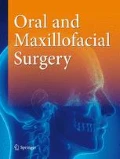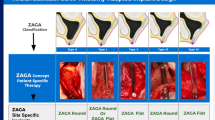Abstract
Objective
This study aims to compare bone-borne (BB) surgically assisted rapid maxillary expansion (SARME) to tooth-borne (TB) SARME with regard to dentoskeletal effects.
Patients and methods
Measurements were performed on 3D scanned cast models of 34 patients preoperatively and 20.5 ± 1.34 months post-expansion. Secondary variables were pterygomaxillary disjunction or not; bimaxillary osteotomy or not and patient age.
Results
BB SARME without pterygomaxillary disjunction on patients <20 years led to a symmetric increase in transverse widening; however, simultaneously, to more dental tipping (canines/second molars) and to the biggest overall attachment loss (frontal teeth/premolars), especially, after the performance of bimaxillary osteotomy. TB SARME led to an asymmetric decrease in transverse widening and to more dental tipping (premolars/first molars).
Conclusion
In long-term effects, BB SARME led to a symmetric increase in transverse widening; however, at the price of frontal attachment loss, resulting from the initial asymmetric, but bigger, overall transverse widening, the initial major segmental rotation and the necessary orthodontics for tooth arch alignment before and after bimaxillary osteotomy.




Similar content being viewed by others
References
Bishara SE, Staley RN (1987) Maxillary expansion: clinical implications. Am J Orthod Dentofacial Orthop 91:3–14
Bell RA (1982) A review of maxillary expansion in relation to rate of expansion and patients age. Am J Orthod 81:32–37
Starnbach H, Bayne D, Cleall J, Subtelny JD (1966) Facioskeletal and dental changes resulting from rapid maxillary expansion. Angle Orthod 36(2):152–164
Silverstein K, Quinn PD (1997) Surgically-assisted rapid palatal expansion for management of transverse maxillary deficiency. J Oral Maxillofac Surg 55:725–727
Glassman AS, Nahigian SJ, Medway JM, Aronowitz HI (1984) Conservative surgical orthodontic adult rapid palatal expansion: sixteen cases. Am J Orthod 86:207–213
Koudstaal MJ, Poort LJ, van der Wal KGH, Wolvius EB, Prahl-Andersen B, Schulten AJ (2005) Surgically assisted rapid maxillary expansion (SARME): a review of the literature. Int J Oral Maxillofac Sur 34:709–714
Landes C, Laudemann K, Schübel F, Petruchin O, Mack M, Kopp S, Sader R (2009) Comparison of tooth-borne and bone-borne devices in SARME by 3D CT-monitoring: transverse dental and skeletal maxillary expansion, segmental inclination, dental tipping and vestibular bone resorption. J Craniofac Surg 20:1132–1141
Sanders NL (1999) Evidence-based care in orthodontics and periodontics: a review of the literature. J Am Dent Assoc 130:521–527
Bassarelli T, Dalstra M, Melsen B (2005) Changes in clinical crown height as a result of transverse expansion of the maxilla in adults. Eur J Orthod 27:121–128
Bierenbroodspot F, Wering PC, Kuijpers-Jagtman AM, Kuijpers-Jagtman AM, Stoelinga PJ (2002) Surgically assisted rapid maxillary expansion: a retrospective study. Ned Tijdschr Tandheelk 109:299–302
Booy A, Dorenbos J, Tuizing DB (2000) Corticotomie een chirurgisch aspect van orthodontie. Ned Tijdschr Tandheelkd 107:213–214
Remmelink HJ (2000) Corticotomie van de bovenkaak: een andere benadering. Ned Tijdschr Tandheelk 107:417
Pinto PX, Mommaerts MY, Wreakes G, Jacobs W (2001) Immediate postexpansion changes following the use of the transpalatal distractor. J Oral Maxillofac Surg 59:994–1000
Ramieri GA, Spada MC, Austa M et al (2005) Transverse maxillary distraction with a bone-anchored appliance: dento-periodontal effects and clinical and radiologic results. Int J Oral Maxillofac Surg 34:357–363
Matteini C, Mommaerts MY (2001) Posterior transpalatal distraction with pterygoid disjunction: a short-term model study. Am J Orthod Dentofac Orthop 120:498–502
Melsen B (2001) Tissue reaction to orthodontic tooth movement—a new paradigm. Eur J Orthod 23:671–681
Andlin-Sobocki A, Bodin L (1993) Dimensional alterations of the gingival related changes of facial/lingual tooth position in permanent anterior teeth of children. A 2-year longitudinal study. J Clin Periodontol 20:219–224
Andlin-Sobocki A, Persson M (1994) The association between spontaneous reversal of gingival recession in mandibular incisors and dentofacial changes in children. A 3-year longitudinal study. Eur J Orthod 16:229–239
Mommaerts MY (1999) Transpalatal distraction as a method of maxillary expansion. Br J Oral Maxillofac Surg 37:268–272
Seitz O, Landes CA, Dissmann DJ, Sader R, Klein CM (2008) Reliable surgically assisted rapid palatal expansion by maxillary widening device. J Craniofac Surg 19:846–849
Tausche E, Hansen L, Hietschold V, Lagravère MO, Harzer W (2007) Three-dimensional evaluation of surgically assisted implant bone-borne rapid maxillary expansion: a pilot study. Am J Orthod Dentofac Orthop 131:S92–S99
Author information
Authors and Affiliations
Corresponding author
Rights and permissions
About this article
Cite this article
Laudemann, K., Petruchin, O., Nafzger, M. et al. Long-term 3D cast model study: bone-borne vs. tooth-borne surgically assisted rapid maxillary expansion due to secondary variables. Oral Maxillofac Surg 14, 105–114 (2010). https://doi.org/10.1007/s10006-009-0194-0
Published:
Issue Date:
DOI: https://doi.org/10.1007/s10006-009-0194-0



